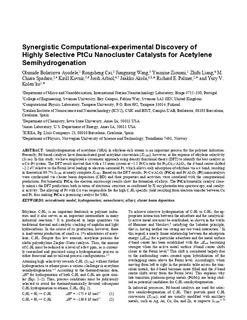Synergistic Computational-Experimental Discovery of Highly Selective PtCu Nanocluster Catalysts for Acetylene Semihydrogenation
Ayodele, Olumide Bolarinwa; Cai, Rongsheng; Wang, Jianguang; Ziouani, Yasmine; Liang, Zhifu; Spadaro, Maria Chiara; Kovnir, Kirill; Arbiol, Jordi; Akola, Jaakko; Palmer, Richard E; Kolen'ko, Yury V
Journal article, Peer reviewed
Accepted version

Åpne
Permanent lenke
http://hdl.handle.net/11250/2646985Utgivelsesdato
2019Metadata
Vis full innførselSamlinger
- Institutt for fysikk [2712]
- Publikasjoner fra CRIStin - NTNU [38679]
Sammendrag
Semihydrogenation of acetylene (SHA) in an ethylene-rich stream is an important process for polymer industries. Presently, Pd-based catalysts have demonstrated good acetylene conversion (XC2H2), however, at the expense of ethylene selectivity (SC2H4). In this study, we have employed a systematic approach using density functional theory (DFT) to identify the best catalyst in a Cu–Pt system. The DFT results showed that with a 55 atom system at ∼1.1 Pt/Cu ratio for Pt28Cu27/Al2O3, the d-band center shifted −2.2 eV relative to the Fermi level leading to electron-saturated Pt, which allows only adsorption of ethylene via a π-bond, resulting in theoretical 99.7% SC2H4 at nearly complete XC2H2. Based on the DFT results, Pt–Cu/Al2O3 (PtCu) and Pt/Al2O3 (Pt) nanocatalysts were synthesized via cluster beam deposition (CBD), and their properties and activities were correlated with the computational predictions. For bimetallic PtCu, the electron microscopy results show the formation of alloys. The bimetallic PtCu catalyst closely mimics the DFT predictions in terms of both electronic structure, as confirmed by X-ray photoelectron spectroscopy, and catalytic activity. The alloying of Pt with Cu was responsible for the high C2H4 specific yield resulting from electron transfer between Cu and Pt, thus making PtCu a promising catalyst for SHA.